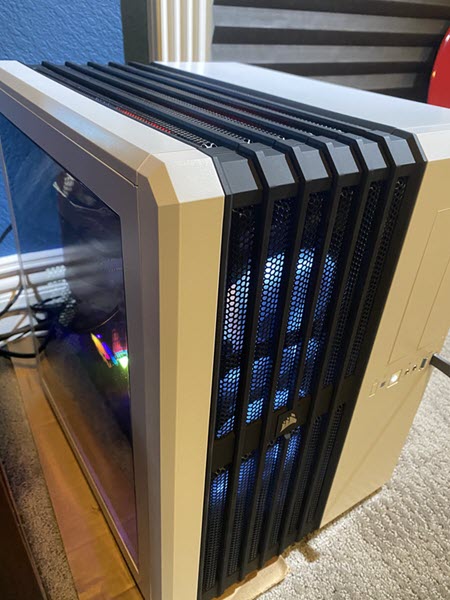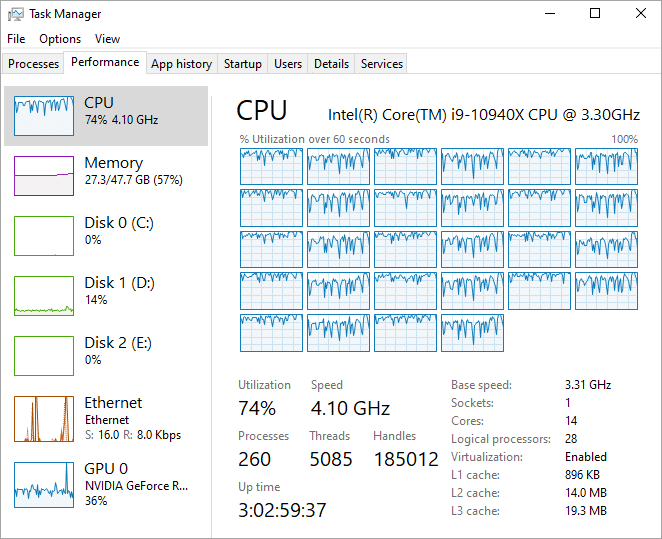2020 Workstation Build
Yooo!
The last workstation was built in August of 2016. It is still holding up, but it is time to build a new machine. I like building a new machine every 3-4 years to stay up to date with the latest technologies. So, here is the build for 2020.

2020 Workstation Components

![]() Case: Corsair Carbide Series Air 540 ($142) – I liked the cube design of this case. In the end it is just a case though. Airflow seems like it will be good with this one.
Case: Corsair Carbide Series Air 540 ($142) – I liked the cube design of this case. In the end it is just a case though. Airflow seems like it will be good with this one.
![]() Power Supply: CORSAIR RMx Series RM850X 850W ($130) – Sticking with the same power supply for this build. The power calculator shows it running at around 680w, so 850 is good.
Power Supply: CORSAIR RMx Series RM850X 850W ($130) – Sticking with the same power supply for this build. The power calculator shows it running at around 680w, so 850 is good.
![]() Motherboard: MSI PRO X299 PRO LGA 2066 Intel X299 ($249) – Motherboard that supports the 10th gen Intel chips. Didn’t really have a lot of options on motherboards that supported the 10th gen chip, so went with this one. 8 memory slots and has all the latest goodies. Also support for two m.2 drives, but will only have one.
Motherboard: MSI PRO X299 PRO LGA 2066 Intel X299 ($249) – Motherboard that supports the 10th gen Intel chips. Didn’t really have a lot of options on motherboards that supported the 10th gen chip, so went with this one. 8 memory slots and has all the latest goodies. Also support for two m.2 drives, but will only have one.
 CPU: Intel Core i9-10940X Cascade Lake 14-Core LGA 2066 ($850) – Lastest 10th Gen Intel chip with 14 physical cores giving 28 logical cores. This will really help to boost things. It will be interesting to see how Adobe Premiere Pro takes advantage of this.
CPU: Intel Core i9-10940X Cascade Lake 14-Core LGA 2066 ($850) – Lastest 10th Gen Intel chip with 14 physical cores giving 28 logical cores. This will really help to boost things. It will be interesting to see how Adobe Premiere Pro takes advantage of this.
 CPU Cooler: Noctua NH-D15 ($90) – Twice the size of the fan used on the 2016 build. 2 fans to give some extra cooling. Combined with the airflow in the case, cooling shouldn’t be a problem.
CPU Cooler: Noctua NH-D15 ($90) – Twice the size of the fan used on the 2016 build. 2 fans to give some extra cooling. Combined with the airflow in the case, cooling shouldn’t be a problem.
 Thermal Paste: Arctic MX-4 ($7) – I’ve always used Arctic Silver for thermal paste on the CPU. I saw this one and will give a go. Need to stay state of the art.
Thermal Paste: Arctic MX-4 ($7) – I’ve always used Arctic Silver for thermal paste on the CPU. I saw this one and will give a go. Need to stay state of the art.
![]() Memory: Corsair Vengeance RGB PRO 64GB Kit ($310) – DDR4 3200 MT/s (PC4-25600). While the motherboard can support up to 128GB of RAM, I didn’t need that in the 2016 build. When video rendering I only usually topped out around 32GB, so 64GB is plenty of space.
Memory: Corsair Vengeance RGB PRO 64GB Kit ($310) – DDR4 3200 MT/s (PC4-25600). While the motherboard can support up to 128GB of RAM, I didn’t need that in the 2016 build. When video rendering I only usually topped out around 32GB, so 64GB is plenty of space.
![]() Harddrive #1: Samsung 970 EVO SSD 1TB ($168) – This is my OS/Boot drive. It was a little tricky getting this to work right, but once I did, it is wonderful! This is a fast hard drive. There are tons of articles that talk about how this is the future of SSD. Drives plugging directly into the PCI bus removing the bottlenecks. I followed this video to get it going without disappearing on me.
Harddrive #1: Samsung 970 EVO SSD 1TB ($168) – This is my OS/Boot drive. It was a little tricky getting this to work right, but once I did, it is wonderful! This is a fast hard drive. There are tons of articles that talk about how this is the future of SSD. Drives plugging directly into the PCI bus removing the bottlenecks. I followed this video to get it going without disappearing on me.
![]() Harddrive #2: Samsung SSD 860 EVO 2TB ($350) – This is my main data drive. Most of my work will be on this drive. Happy to be upping the space to 2TB. The 1TB drive filled up pretty quickly.
Harddrive #2: Samsung SSD 860 EVO 2TB ($350) – This is my main data drive. Most of my work will be on this drive. Happy to be upping the space to 2TB. The 1TB drive filled up pretty quickly.
![]() Harddrive #3: Seagate 4TB Gaming SSHD(Solid State Hybrid Drive) SATA 6Gb/s 64MB Cache – Moving this drive from the 2016 machine over to the 2020 machine. Will be an archive drive. One of the 3 archive systems I use.
Harddrive #3: Seagate 4TB Gaming SSHD(Solid State Hybrid Drive) SATA 6Gb/s 64MB Cache – Moving this drive from the 2016 machine over to the 2020 machine. Will be an archive drive. One of the 3 archive systems I use.
 Graphics Card: MSI Gaming GeForce RTX 2080 Super 8GB ($750) – This is pretty top of the line. This will help with video rendering – as well as video games.
Graphics Card: MSI Gaming GeForce RTX 2080 Super 8GB ($750) – This is pretty top of the line. This will help with video rendering – as well as video games.
I also picked up some cables to make sure I had what I needed.
2020 Workstation results
The results are positive for the new build. I can definitely see improvement in performance on the rendering side.
Editing Improvements
Editing within Premiere Pro and After Effects didn’t really change much. They were pretty spunky before, and are the same on this machine.
Rendering
Here is the last video I rendered on my 2016 desktop machine. The length of the video was about 6 minutes.
- Video: 1920x1080 (1.0), 23.976 fps, Progressive, Software Encoding, 00:05:55:18
- Audio: AAC, 320 kbps, 48 kHz, Stereo
- Bitrate: VBR, 1 pass, Target 16.00 Mbps, Max 16.00 Mbps
- Encoding Time: 00:07:28
That took 7.5 minutes. Here is what it took on the new workstation.
- Video: 1920x1080 (1.0), 23.976 fps, Progressive, Software Encoding, 00:05:55:18
- Audio: AAC, 320 kbps, 48 kHz, Stereo
- Bitrate: VBR, 1 pass, Target 16.00 Mbps, Max 16.00 Mbps
- Encoding Time: 00:02:19
The new build shaved off about 5 minutes of rendering time. Not to shabby. That probably doesn’t seem like a lot, but it is. Also, not as substantial an improvement as it was from the old laptop to the 2016 build. At some point you will get diminishing returns.
Here is a look at Task Manager while the video was rendering.
